JOHN S. ALLEN'S BICYCLE FACILITIES, LAWS AND PROGRAMS PAGES |
||
 |
Top: Home Page Up: Bicycle facilities |
 |
JOHN S. ALLEN'S BICYCLE FACILITIES, LAWS AND PROGRAMS PAGES |
||
 |
Top: Home Page Up: Bicycle facilities |
 |
When does
|
Two-way bicycle lane, Olympia, Washington, USA, 1991
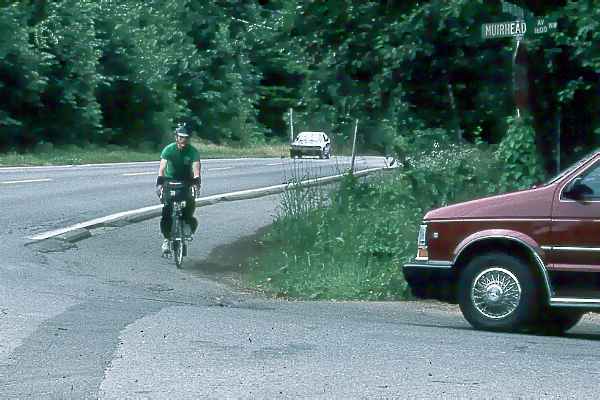
It has been shown again and again that riding opposite the flow
of traffic is hazardous. But an important distinction needs to be made between two
types of contraflow installations:
"Right-way" contraflow is fundamentally not different from a normal two-way street, but it does raise some unique issues, as we shall see -- the devil is in the details, and a blanket endorsement of such facilities is not prudent. A street may be made one-way for any or all of three major reasons:
Bicycles are generally slower than motor vehicles, and bicycle trips tend to be shorter than motorized trips. For these reasons, a round-about route imposed by a one-way street is generally a greater inconvenience to cyclists than to motorists, and contraflow installations are of particular interest on one-way local streets in urban areas. A "right-way" contraflow installation may provide a link in an important and useful route which has been denied by the one-way street. The following example is of just such an installation. London, England: a "right way" contraflow installationConsider a two-way street like any other street, except that motor vehicles are prohibited from traveling in one direction. Bicyclists travel on the correct side of the roadway in one direction; bicycles and other traffic, on the correct side in the other direction. The next pair of photos below shows an example of such an installation in London, England which uses a designated bicycle lane. Alan Forkosh, who took these photos, describes them:
The first photo shows the intersection which leads up to the contraflow lane. Remember, in England, traffic keeps to the left side of the street -- the vehicle in the foreground is parked facing oncoming traffic (though Alan Forkosh informs me that is legal in the location shown). The right-turn bike lane in the center of the street channels bicyclists toward the two low posts with yellow markings at the far side of the intersection. This right-turn lane appears to direct bicycle traffic in the "wrong" direction -- the street that comes in from the right side in the picture is one-way from right to left. However, it is two-way for bicycles. |
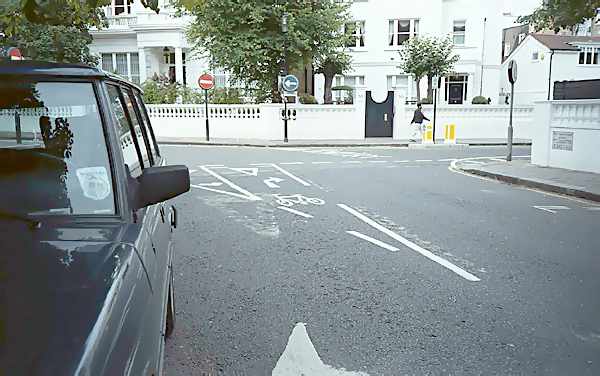 Alan Forkosh |
| In the next photo, we look down that street past the two posts. Bicyclists are channeled here into a contraflow bike lane. The bike lane is in the normal location, on the left side of the street relative to oncoming traffic. Every feature of this treatment anticipates normal vehicular movements, by bicyclists as well as motorists. There is only one location at which vehicular traffic may cross the bike lane: a driveway (just behind the yellow posts in the photo). |
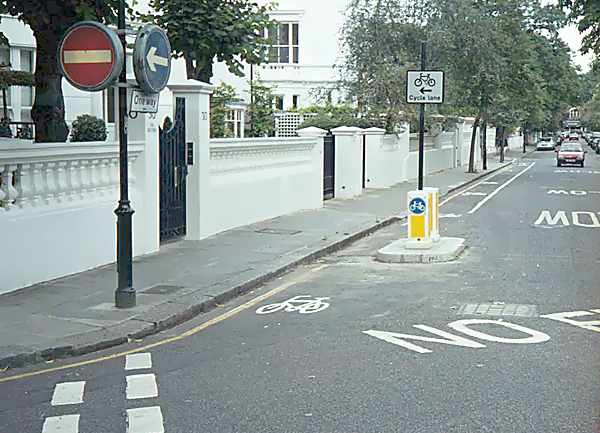 Alan Forkosh |
| Still, there are a few peculiarities and problems with this installation. The short
median barrier, intended to discourage cyclists from cutting the corner, leaves a channel
too narrow for a cargo tricycle or trailer. These would have to pass to the right of the
barrier. One potential problem with a contraflow lane is that it places cyclists in close proximity to opposite-direction traffic, making it harder to avoid collisions with vehicles that fail to yield when turning. For example, the red car headed toward the camera in the photo above might make a right turn into the driveway, the equivalent of a left turn in countries where traffic keeps right. Cyclists can normally negotiate with overtaking motorists and merge toward the center of the roadway to get past slower cyclists or obstructions. But a contraflow lane would require merging into oncoming traffic. That can't be done: it is necessary to wait for a long gap, as when overtaking on any two-lane, two-way roadway. Possibly in an attempt to mitigate conflicts with oncoming traffic, the striping in the London installation defines the bike lane as narrower than the space occupied by parked vehicles in the next block (in the background in the photo). But the travel lane for oncoming traffic is rather wide. A painted median (a "gore") and/or a wider contraflow lane would direct motorists to stay farther away from the cyclists and allow cyclists to overtake without encroaching into the oncoming lane. The London installation largely avoids one serious conceptual problem with contraflow lanes -- cyclists' taking unexpected routes across intersections. Let's look at the first photo of the London installation again in connection with this problem. |
 Alan Forkosh |
| Drivers entering the intersection from the street at the right rear of the
photo (the street with the contraflow lane) have to be on the lookout for
left-turning motor vehicles entering from the same direction as the right-turning
cyclists. But drivers crossing from the left rear to the right front in the photo might
not expect cyclists to be turning from their special right-turn lane into the contraflow
lane. The cyclists are required to yield, removing the burden of responsibility from the
drivers -- note the yield triangle painted on the roadway. There is nothing special about
yielding here: turning traffic normally yields to other traffic. Drivers exiting the driveway in the London installation might forget to look to the right for cyclists -- all other traffic on the roadway comes from the left. Pedestrians also might forget to look to the right. At the exit of the contraflow lane at its far end, there is no potential for confusion by vehicle operators, because the bicycle traffic goes left around a corner without crossing a lane of traffic (same as a right turn in countries where traffic keeps right). Potential conflicts at an intersectionThe London installation gives some examples of how cyclists can sometimes appear from unexpected directions. The illustration below gives more examples. (We return here to right-side driving.). If the intersection is not signalized, cyclists a, b and c, who are turning left, would normally yield to all other traffic in the intersection. Whether cyclist d, going straight across, would yield depends on the assignment of priority at this intersection. |
Potential confusion with a contraflow bike lane. All of the
cyclists are operating
according to the normal vehicular rules of the road, but cyclists b, c and d,
entering, leaving and crossing in the contraflow lane, come from unexpected
directions if drivers assume that the street with the contraflow lane
is an ordinary one-way street.

| The illustration shows what is nearly a "worst-case" situation -- a
contraflow lane on a minor street, crossing a multilane street. Typically, a stop sign
would require traffic on the minor street -- including cyclist d
-- to yield, but note the "multiple threat" to the left of cyclist d,
where a turning car hides a car that is going straight through. The cyclist must be aware
of the possibility that one vehicle hides another. If the traffic on the
multilane street is heavy -- as is usual -- cyclists may have few opportunities to
cross safely, and such hazards are likely. Such problems are inherent wherever a minor street crosses a multilane arterial, but the problems are worse when cyclists appear from an unexpected direction. As an alternative to the contraflow lane, bicycle travel on a larger street with an intersection that would in any case be signalized would avoid these problems, though it might not be as direct to certain destinations, or as pleasant. However, if a reduction of efficiency of travel on the arterial is acceptable, then signalization on the minor-street contraflow route can reduce hazards. Especially if traffic in the street with the contraflow lane is light, then the signals are best controlled by bicycle-sensitive actuators, in order to avoid unnecessary delay either to the cyclists or to other traffic. And of course, the cyclists must obey the signals if the signals are to be effective. If delays are too great, then compliance with the signals becomes less likely. A barrier-separated contraflow lane on a major arterialUniversity Avenue, in Madison, Wisconsin, USA is a major arterial street that was made one-way in the interest of more efficient traffic flow. Johnson Street, one block to the south, serves traffic in the other direction. But University Avenue bisects the campus of the University of Wisconsin, which has over 40,000 students. University Avenue therefore carries large numbers of cyclists who are making short trips. The resulting temptation to travel opposite traffic was mitigated by installation of a contraflow bike lane, visible at the left side of the photo below. This lane was originally a contraflow bus lane. When it was made into a bike lane, the eastbound bus route was moved over to Johnson Street. University Avenue may be described as a two-way divided street with eastbound traffic restricted to bicycles only. The intersections on University Avenue are signalized. Signage for streets crossing University Avenue typically indicates turn restrictions with exceptions for bicyclists, rather than to use one-way signs. |
Contraflow bike lane (left side of photo) on University
Avenue,
Madison, Wisconsin, USA. For "right-way" bicycle traffic, University Avenue
has a bike lane to the left of a bus lane (right side of photo).
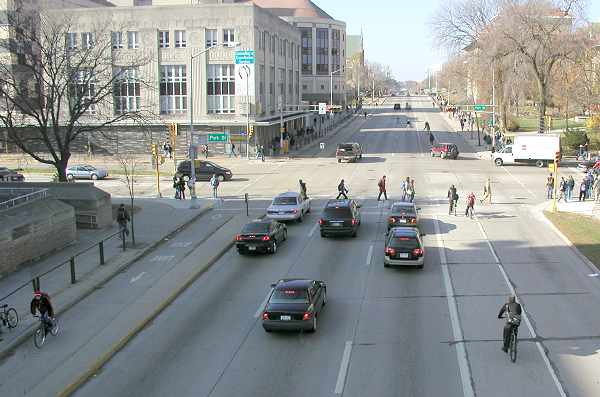 Ann Freiwald, |
Arthur Ross, Pedestrian-Bicycle Coordinator for the City of Madison and a League of
American Bicyclists Cycling Instructor, has explained the contraflow lane this way:
League Cycling Instructor Judy Murphy attended the Bicycle Education Leaders Conference in Madison in the spring of 2002, and has the following comments about the contraflow lane:
Rewey adds the comment:
Rewey's comment makes it clear that attention has been paid to the effect of signal timing on the contraflow bicycle traffic. The signal timing for motorists and cyclists becomes more compatible when motor traffic is slow. However, no signal timing can be optimal for all cyclists, as typical bicycle travel speeds on level ground cover a 3-to-1 range. The greatest throughput of motor traffic (most vehicles passing a given point within a given time period) is achieved at a travel speed of 22 miles per hour (35 km/h) and this is approximately the speed of the fastest cyclists. I add a few thoughts about the important advantages of the University Avenue contraflow lane, as well as some of the practical difficulties with it: Because the lane is a contraflow lane, the barrier serves the same function as an ordinary median strip. The contraflow lane does not require any nonstandard traffic movements, and it is wide enough that cyclists can overtake one another without the risk of toppling over the curb on either side. The Herald Square, New York City barrier bike lane provides a contrasting example. In the photo, note the fence which has been erected to prevent pedestrians from straying into the contraflow lane. Alan Forkosh comments that
Pedestrians' failure to notice cyclists does not reflect any conflict between the design of the lane and traffic theory; rather, it reflects pedestrians' not taking bicycle traffic as seriously as motor traffic. In some places, there is a fence on both sides of University Avenue to restrict pedestrian movements. Debris is a problem with any barrier-separated lane, but this lane is wide enough for standard-width vehicles, including street sweepers. The University Avenue lane also is wide enough for a standard snowplow. It is plowed, sanded and salted in winter. Still, pounding by motor vehicle wheels greatly accelerates snow clearance, and this pounding does not occur in a barrier-separated lane. The lane is also on the shaded side of the street. But there was no choice in this matter -- and not only because of the pre-existing bus lane. Ross describes the issues at hand:
Ross has also made the point that Madison's facilities have to be understood in their historical and political context, and I think that is a valid point. The Madison and Wisconsin D.O.T. engineers are themselves cyclists, they are serious readers of and contributors to the research literature, and they look for solutions which are relatively conservative while also being innovative where necessary. As to the problem with the wrong-way and sidewalk cyclists, the contraflow lane effected an improvement, but the $64,000 question in a university town like Madison is how to get bicycling education to the students. Germany: contraflow without special lanes
The German opening of one-way streets to contraflow bicycle traffic is probably the most extensive anywhere. There is another page from the ADFC site (now available in English) which goes into more technical detail. A reading of the research documents cited in that page would provide more detail yet, and the opportunity for an independent evaluation. One of these documents, an important summary of research, is now available in English. German law specifically permits cyclists to use as much of the roadway as is needed to avoid the hazards of parked cars. There are no designated bike lanes in these installations except on arterial streets. In the case of narrow streets, there will necessarily be head-on conflicts. The Germans appear to choose and enforce low speed limits consistent with the available roadway width. "Right-way" contraflow with "wrong way" parkingContraflow bicycle travel adjacent to "wrong-way" parking apparently exists in some of the German installations, if I read the ADFC pages correctly. It has been formalized in the USA in Cambridge, Massachusetts; Berkeley, California; and perhaps other locations. All of the Cambridge installations use bike lanes. One Cambridge installation is in two sections, on Waterhouse Street and Little Concord Avenue. Another on Scott Street is an important link in a route that crosses a railroad line, where few other crossings are available. The block of Scott Street shown in the photo below was made one-way many years ago to reduce the volume of through traffic on residential streets. In the year 1999 or 2000, a contraflow bike lane was added. Parking on both sides, plus a contraflow bike lane, require cyclists to travel in the "door zone" and also very close to oncoming vehicles -- and with a 30 mph (48 km/h) speed limit. This speed limit is imposed by state law; the City of Cambridge would like to have the option to set its own speed limits. |
Scott Street, Cambridge, Massachusetts: contraflow bike lane
in the "door zone" adjacent to wrong way parking. It is possible that the
cyclist entered the intersection legally on a yellow signal, though
the signal is now red.
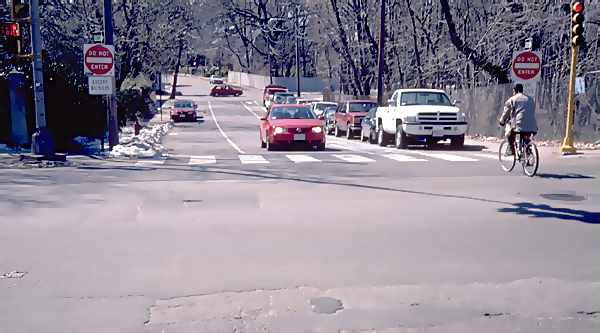
| Wrong-way parking raises serious issues of human abilities, traffic theory and
liability risk, because motorists who wish to enter or leave a parking spot must merge
across oncoming traffic. Entering a parking space is much like making a left turn. The driver merges to the center of the roadway (adjacent to the contraflow bike lane) and then need only look for traffic in the forward arc of vigilance to turn across the bike lane into the parking spot. As the bike lane is narrow, cyclists do have less time to anticipate and avoid a vehicle entering a parking spot than to avoid left-turning vehicles on an ordinary two-way street. Once a vehicle is parked, the driver gets out on the curb side, reducing the likelihood of a car-door collision with a bicyclist riding in the "door zone." A passenger getting out of the car on the street side also has a relatively easy time observing oncoming cyclists, who are in the passenger's forward field of vision. But the situation is much more difficult when a vehicle is leaving a parking space next to a contraflow bike lane. The driver must look both forward and back to yield to vehicular traffic. The driver, on the curb side of the vehicle, can not see very well if there are vehicles in adjacent parking spaces. In the photo above, the driver of the sedan in the second parking space from the corner would not see the cyclist past the tall pickup truck. By way of contrast, a driver exiting a normal, right-side parking space is on the street side and can look back to see traffic approaching from the rear -- the only direction from which traffic in the adjacent lane may legally approach. |
Issues with a contraflow bike lane adjacent to parking.
Driver of light blue car (c)
can exit to sidewalk without opening door into bike lane, but driver of car (b),
exiting parking spot, is on curb side and may not see car (a) or the cyclist
in time to avoid a collision. Car (a) prevents the cyclist from merging out of
the bike lane to avoid car (b).
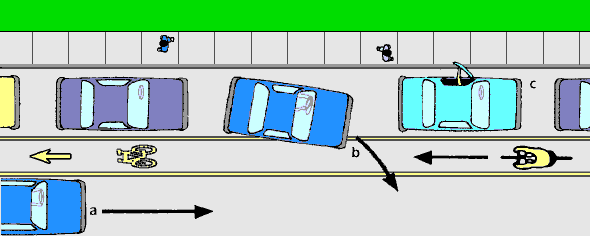
| Normally, the task of a driver who is required to yield right of way is kept as simple
as possible. Contraflow parking violates this principle, especially when a bike lane is
crammed in next to the parked cars. The German laws, and the German installations without
bike lanes, permit bicyclists to maintain a comfortable distance from parked cars and
carry the implication that motorists must sometimes slow and give way to an approaching
cyclist. The Scott Street lane, on the other hand, requires cyclists to run a gauntlet of
cars which could exit parking spaces without warning. I asked Cara Seiderman, Cambridge Bicycle/Pedestrian Coordinator, about the installation on Scott Street, and her answer was that parking turnover is low. Is it acceptable in traffic engineering to reduce only the statistical likelihood of a collision, without providing drivers the opportunity properly to yield right of way? There are only 10 wrong-way parking spaces on Scott Street. Here's the photo again so you can count them. That the parking spaces were allowed to exist despite the threat they pose to public safety gives some idea of the pressure to provide parking spaces on public streets. |

The American Association for the Advancement of Science has its national offices in a
large tract of land behind the trees at the right side of the photo. The need for parking
spaces at this location could be absorbed if the AAAS and perhaps a few local businesses
provided more on-site parking for employees and visitors. But also note that in the photo,
taken in mid-afternoon on a weekday, most of the parking spaces on the other side of Scott
Street are empty! The empty spaces are designated for residents with parking permits,
explaining why so few of them are occupied at midday.Berkeley, California: bollards but no bike laneMilvia Street in Berkeley, California is a residential street which runs parallel to Shattuck Avenue, a heavily traveled arterial with narrow lanes. Milvia Street is used as a "bicycle boulevard" -- a two-way through route for cyclists on which motor traffic volume and speed are reduced by various measures. The contraflow installation on one block of Milvia Street is one of these measures. Like many German contraflow installations, the Milvia Street installation does not use a bike lane. Milvia Street also has ample width so bicyclists need not ride in the door zone. Unlike the German installations, which use only signage at intersections, the Milvia Street installation has heavy concrete bollards to prevent motor vehicles from entering at one end of the block (photos taken April, 1999). This installation is what is called in the German literature a "false one-way street" (explanation on another Web page). Alan Forkosh comments:
In Berkeley, there are several blocks on residential streets that have bollards or other barriers all the way across rather than halfway across at one end, so only bicycles can enter or exit at that end. These cul-de-sac blocks are even less like conventional one-way streets. Forkosh continues:
|
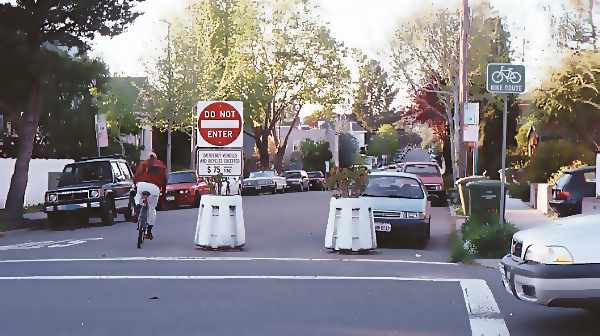
| Both times I observed the Milvia Street installation, a cyclist traveling in the
contraflow direction crossed to the left side of the street rather than to ride between
the bollards. In the photo above, the cyclist appears to be avoiding the car exiting the side street at the right, as well as a possible dooring from a parked car, or a collision with a car pulling out of a driveway. In the photo below, taken on a different day, the cyclist is forced to go around the bollards, because an illegally double-parked car blocks the channel between them.. |
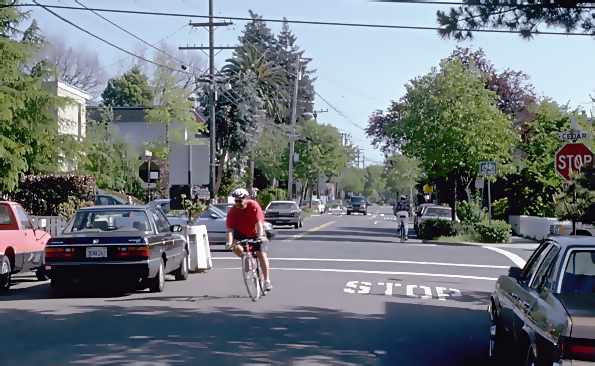
ConclusionsAll in all, my opinion is that "right-way" contraflow installations are a reasonable idea if carefully designed and located. They can clearly improve the convenience of bicycle travel. As Arthur Ross has pointed out, they also can reduce the risk of crashes by shortening trips and by providing a route that avoids trouble spots. But the problems illustrated in some of the examples above -- and perhaps other problems -- need to be addressed if an installation is to be successful. In many cases, the problems may be serious enough that a contraflow installation should not be considered. Research has been conducted into the safety of the Madison, Wisconsin installation and the German installations. I don't know of any studies of the Berkeley or Cambridge installations. Thanks to Alan Forkosh, John Schubert, Judy Murphy, Arthur Ross, Michael Rewey, Ann Freiwald, Fred Oswald and the German Cycling Federation ADFC for their contributions to this page. |
| Top: Home Page Up: Bicycle facilities |
Contents � 2002, John S. Allen |